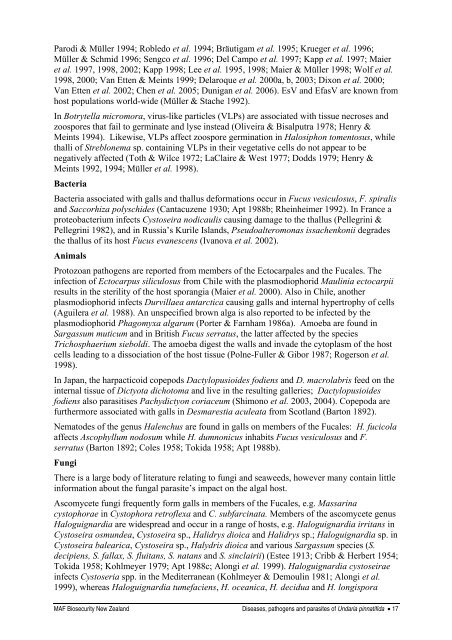Diseases, pathogens and parasites of Undaria pinnatifida
Diseases, pathogens and parasites of Undaria pinnatifida
Diseases, pathogens and parasites of Undaria pinnatifida
You also want an ePaper? Increase the reach of your titles
YUMPU automatically turns print PDFs into web optimized ePapers that Google loves.
Parodi & Müller 1994; Robledo et al. 1994; Bräutigam et al. 1995; Krueger et al. 1996;<br />
Müller & Schmid 1996; Sengco et al. 1996; Del Campo et al. 1997; Kapp et al. 1997; Maier<br />
et al. 1997, 1998, 2002; Kapp 1998; Lee et al. 1995, 1998; Maier & Müller 1998; Wolf et al.<br />
1998, 2000; Van Etten & Meints 1999; Delaroque et al. 2000a, b, 2003; Dixon et al. 2000;<br />
Van Etten et al. 2002; Chen et al. 2005; Dunigan et al. 2006). EsV <strong>and</strong> EfasV are known from<br />
host populations world-wide (Müller & Stache 1992).<br />
In Botrytella micromora, virus-like particles (VLPs) are associated with tissue necroses <strong>and</strong><br />
zoospores that fail to germinate <strong>and</strong> lyse instead (Oliveira & Bisalputra 1978; Henry &<br />
Meints 1994). Likewise, VLPs affect zoospore germination in Halosiphon tomentosus, while<br />
thalli <strong>of</strong> Streblonema sp. containing VLPs in their vegetative cells do not appear to be<br />
negatively affected (Toth & Wilce 1972; LaClaire & West 1977; Dodds 1979; Henry &<br />
Meints 1992, 1994; Müller et al. 1998).<br />
Bacteria<br />
Bacteria associated with galls <strong>and</strong> thallus deformations occur in Fucus vesiculosus, F. spiralis<br />
<strong>and</strong> Saccorhiza polyschides (Cantacuzene 1930; Apt 1988b; Rheinheimer 1992). In France a<br />
proteobacterium infects Cystoseira nodicaulis causing damage to the thallus (Pellegrini &<br />
Pellegrini 1982), <strong>and</strong> in Russia’s Kurile Isl<strong>and</strong>s, Pseudoalteromonas issachenkonii degrades<br />
the thallus <strong>of</strong> its host Fucus evanescens (Ivanova et al. 2002).<br />
Animals<br />
Protozoan <strong>pathogens</strong> are reported from members <strong>of</strong> the Ectocarpales <strong>and</strong> the Fucales. The<br />
infection <strong>of</strong> Ectocarpus siliculosus from Chile with the plasmodiophorid Maulinia ectocarpii<br />
results in the sterility <strong>of</strong> the host sporangia (Maier et al. 2000). Also in Chile, another<br />
plasmodiophorid infects Durvillaea antarctica causing galls <strong>and</strong> internal hypertrophy <strong>of</strong> cells<br />
(Aguilera et al. 1988). An unspecified brown alga is also reported to be infected by the<br />
plasmodiophorid Phagomyxa algarum (Porter & Farnham 1986a). Amoeba are found in<br />
Sargassum muticum <strong>and</strong> in British Fucus serratus, the latter affected by the species<br />
Trichosphaerium sieboldi. The amoeba digest the walls <strong>and</strong> invade the cytoplasm <strong>of</strong> the host<br />
cells leading to a dissociation <strong>of</strong> the host tissue (Polne-Fuller & Gibor 1987; Rogerson et al.<br />
1998).<br />
In Japan, the harpacticoid copepods Dactylopusioides fodiens <strong>and</strong> D. macrolabris feed on the<br />
internal tissue <strong>of</strong> Dictyota dichotoma <strong>and</strong> live in the resulting galleries; Dactylopusioides<br />
fodiens also parasitises Pachydictyon coriaceum (Shimono et al. 2003, 2004). Copepoda are<br />
furthermore associated with galls in Desmarestia aculeata from Scotl<strong>and</strong> (Barton 1892).<br />
Nematodes <strong>of</strong> the genus Halenchus are found in galls on members <strong>of</strong> the Fucales: H. fucicola<br />
affects Ascophyllum nodosum while H. dumnonicus inhabits Fucus vesiculosus <strong>and</strong> F.<br />
serratus (Barton 1892; Coles 1958; Tokida 1958; Apt 1988b).<br />
Fungi<br />
There is a large body <strong>of</strong> literature relating to fungi <strong>and</strong> seaweeds, however many contain little<br />
information about the fungal parasite’s impact on the algal host.<br />
Ascomycete fungi frequently form galls in members <strong>of</strong> the Fucales, e.g. Massarina<br />
cystophorae in Cystophora retr<strong>of</strong>lexa <strong>and</strong> C. subfarcinata. Members <strong>of</strong> the ascomycete genus<br />
Haloguignardia are widespread <strong>and</strong> occur in a range <strong>of</strong> hosts, e.g. Haloguignardia irritans in<br />
Cystoseira osmundea, Cystoseira sp., Halidrys dioica <strong>and</strong> Halidrys sp.; Haloguignardia sp. in<br />
Cystoseira balearica, Cystoseira sp., Halydris dioica <strong>and</strong> various Sargassum species (S.<br />
decipiens, S. fallax, S. fluitans, S. natans <strong>and</strong> S. sinclairii) (Estee 1913; Cribb & Herbert 1954;<br />
Tokida 1958; Kohlmeyer 1979; Apt 1988c; Alongi et al. 1999). Haloguignardia cystoseirae<br />
infects Cystoseria spp. in the Mediterranean (Kohlmeyer & Demoulin 1981; Alongi et al.<br />
1999), whereas Haloguignardia tumefaciens, H. oceanica, H. decidua <strong>and</strong> H. longispora<br />
MAF Biosecurity New Zeal<strong>and</strong> <strong>Diseases</strong>, <strong>pathogens</strong> <strong>and</strong> <strong>parasites</strong> <strong>of</strong> <strong>Undaria</strong> <strong>pinnatifida</strong> • 17

















